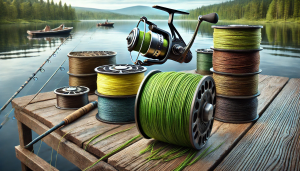Currently Empty: $0.00

When I first started fishing, the vast array of fishing lines available on the market overwhelmed me. However, one type of fishing line that consistently caught my attention was braided fishing line. Over time, I’ve come to appreciate its unique properties and how it revolutionized the fishing world. But what exactly is braided fishing line, and why has it become such a staple for anglers worldwide? In this article I will cover the origins, durability, and the challenges of this line.
The Origins of Braided Fishing Line
Braided fishing line has a rich history that dates back to ancient times. Long before the advent of modern synthetic materials, early anglers relied on natural fibers to create their fishing lines. These fibers, often made from cotton, linen, or silk, were intricately braided together to form a strong and durable line. While these early braided lines served their purpose, they were far from the high-performance lines we use today.
The significant evolution of braided fishing line began in the 20th century with the introduction of synthetic materials. The development of polyethylene, a strong and lightweight plastic, was a game-changer. This material, known for its high tensile strength and low stretch, became the foundation for modern braided fishing lines. As manufacturers refined the braiding process, the lines became even thinner, stronger, and more durable, making them a popular choice.
Why Choose Braided Line?
From my personal experience, I can confidently say that braided line offers several distinct advantages over other types of fishing lines. One of the most notable benefits is its incredible strength-to-diameter ratio. Unlike monofilament or fluorocarbon lines, braided fishing line is made up of multiple strands of polyethylene fibers tightly woven together.
For example, a braided line with a 20-pound test strength can have the same diameter as a 6-pound test monofilament line. This allows anglers to pack more line onto their reels, making it an excellent choice for deep-sea fishing or when targeting large, hard-fighting fish. Additionally, the thin diameter of braided line reduces water resistance.
The Durability
Another reason why I favor braided fishing line is its exceptional durability. Unlike monofilament lines, which can degrade over time due to exposure to UV rays, water, and abrasion, braided line is incredibly resistant to these factors. This means that anglers can use braided line for extended periods without worrying about it weakening or breaking.
Braided fishing line also boasts near-zero stretch, providing anglers with superior sensitivity. This is particularly beneficial when fishing in deep waters or when using techniques that require precise lure control. With braided line, I can feel even the slightest nibble or change in the bottom structure, allowing for quicker and more effective hooksets.
The Versatility
One of the aspects of braided fishing line that I find most appealing is its versatility. It can be used in various fishing environments, from freshwater lakes and rivers to saltwater oceans. Whether you’re trolling, casting, or jigging, braided line performs exceptionally well in all conditions.
Moreover, braided is available in a wide range of colors, allowing anglers to choose a line that blends in with the environment or stands out for better visibility. Some anglers prefer high-visibility colors like neon green or yellow, which makes it easier to track the line’s movement. Others opt for more subtle colors like moss green or dark brown to blend in.
The Challenges
While braided line offers many advantages, it’s essential to acknowledge some of its challenges. One issue I’ve encountered is its tendency to slip on the reel spool. Unlike monofilament, which grips the spool tightly, braided line can sometimes spin under pressure, especially when reeling in a large fish.
Another challenge with braided line is its visibility in clear water. Because braided line doesn’t refract light like monofilament or fluorocarbon, it can be more noticeable to fish, especially in crystal-clear conditions. To counteract this, I often use a fluorocarbon leader, which combines the benefits of both lines.
Braided Fishing Line vs. Other Types of Fishing Line
In comparing braided fishing line to other types, such as monofilament and fluorocarbon, it’s clear that each has its own set of advantages and disadvantages. Monofilament, for instance, is known for its stretch and shock absorption, making it ideal for certain techniques, like trolling or fishing with treble hooks. However, it lacks the sensitivity and strength of braided line.
Fluorocarbon, on the other hand, is nearly invisible underwater, making it an excellent choice for clear water conditions. However, it is stiffer and more prone to memory than braided line, which can affect casting distance and accuracy. By understanding the strengths and weaknesses of each type of line, anglers can make informed decisions.
Conclusion
In my years of fishing, I’ve come to rely on braided fishing line for its strength, durability, and versatility. It has proven itself time and time again in a variety of fishing scenarios, from battling big game fish in the ocean to casting for bass in freshwater lakes. While it may not be the perfect choice for every situation, its properties make it an invaluable tool in any angler’s arsenal.
Whether you’re a seasoned angler or just starting out, I encourage you to give braided line a try. Its impressive performance and longevity make it a worthwhile investment, and with proper care, it can serve you well for many fishing trips to come. Understanding what braided fishing line is and how it can enhance your fishing experience is the first step.


